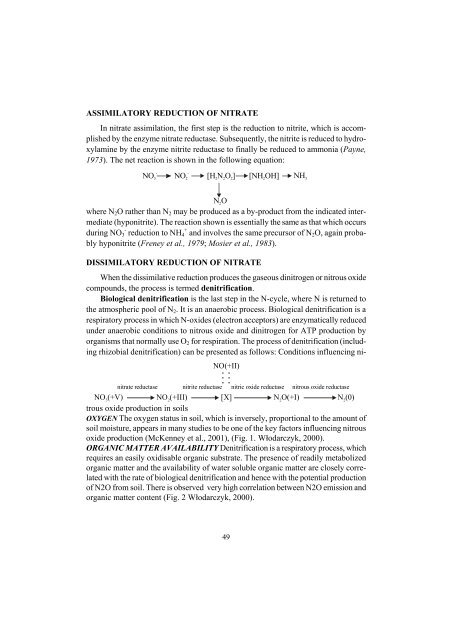soil - Lublin
soil - Lublin
soil - Lublin
Create successful ePaper yourself
Turn your PDF publications into a flip-book with our unique Google optimized e-Paper software.
ASSIMILATORY REDUCTION OF NITRATE<br />
In nitrate assimilation, the first step is the reduction to nitrite, which is accomplished<br />
by the enzyme nitrate reductase. Subsequently, the nitrite is reduced to hydroxylamine<br />
by the enzyme nitrite reductase to finally be reduced to ammonia (Payne,<br />
1973). The net reaction is shown in the following equation:<br />
NO 3<br />
-<br />
NO 2<br />
-<br />
[H N O ]<br />
2 2 2 [NH OH] 2 NH 3<br />
NO 2<br />
where N 2 O rather than N 2 may be produced as a by-product from the indicated intermediate<br />
(hyponitrite). The reaction shown is essentially the same as that which occurs<br />
during NO 3 - reduction to NH 4 + and involves the same precursor of N 2 O, again probably<br />
hyponitrite (Freney et al., 1979; Mosier et al., 1983).<br />
DISSIMILATORY REDUCTION OF NITRATE<br />
NO(+II)<br />
nitrate reductase nitrite reductase nitric oxide reductase nitrous oxide reductase<br />
When the dissimilative reduction produces the gaseous dinitrogen or nitrous oxide<br />
compounds, the process is termed denitrification.<br />
Biological denitrification is the last step in the N-cycle, where N is returned to<br />
the atmospheric pool of N 2 . It is an anaerobic process. Biological denitrification is a<br />
respiratory process in which N-oxides (electron acceptors) are enzymatically reduced<br />
under anaerobic conditions to nitrous oxide and dinitrogen for ATP production by<br />
organisms that normally use O 2 for respiration. The process of denitrification (including<br />
rhizobial denitrification) can be presented as follows: Conditions influencing ni-<br />
NO<br />
3(+V)<br />
NO<br />
2<br />
(+III) [X] N2O(+I)<br />
N(0)<br />
2<br />
trous oxide production in <strong>soil</strong>s<br />
OXYGEN The oxygen status in <strong>soil</strong>, which is inversely, proportional to the amount of<br />
<strong>soil</strong> moisture, appears in many studies to be one of the key factors influencing nitrous<br />
oxide production (McKenney et al., 2001), (Fig. 1. Włodarczyk, 2000).<br />
ORGANIC MATTER AVAILABILITY Denitrification is a respiratory process, which<br />
requires an easily oxidisable organic substrate. The presence of readily metabolized<br />
organic matter and the availability of water soluble organic matter are closely correlated<br />
with the rate of biological denitrification and hence with the potential production<br />
of N2O from <strong>soil</strong>. There is observed very high correlation between N2O emission and<br />
organic matter content (Fig. 2 Włodarczyk, 2000).<br />
49

















